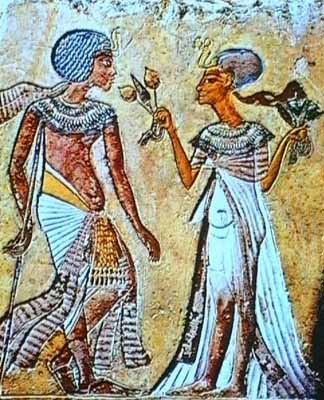
To make a complete break, the king and his queen, left Thebes behind and moved to a new capital in Middle Egypt, 180 miles north of Thebes half way between Memphis and Thebes.
It was a virgin site, not previously dedicated to any other god or goddess, and he named it Akhetaten - The Horizon of the Aten.
Today the site is known as El-Amarna.
In essence he was an cult leader taking his following into the mountains and desert to build a new paradise.
Akhenaten established his new religion by building an entire city dedicated to Aten complete with a necropolis and royal tomb.
In 1346 BC work began on this new city built in middle Egypt, on a site thought to have been chosen as it was not tainted by the worship of the other gods.
In 1344 BC the central section of Akhetaten was completed.
Nefertiti's prominent role in Egyptian royal rule and religious worship reflects her influence in the public sphere. During the early years of her royal reign, Nefertiti as part of her religious conversion changed her name. Nefertiti which means "The-beautiful-one -is come" became Neferneferuaten-Nefertiti or "The-Aten-is -radiant-of-radiance [because] the-beautiful-one-is come". A different interpretation of the name change, translated Neferneferuaten to mean--"Perfect One of the Aten's Perfection".
Following his wife's lead, Amenhotep IV changed his name in the fifth year of his reign to Akhenaten.
In 1342 BC the seat of government was transferred to Akhetaten


